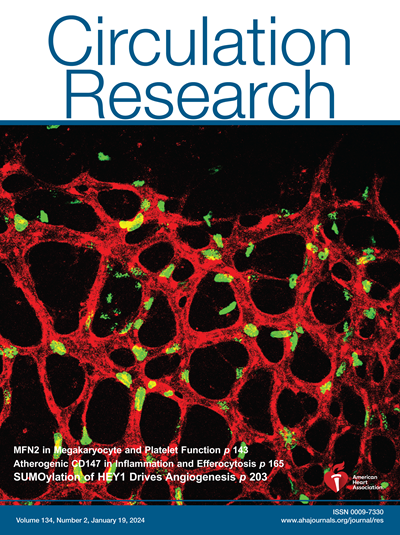Paracrine Smooth Muscle-to-Endothelial Signaling via TNF Elevates Blood Pressure in Obesity.
IF 16.2
1区 医学
Q1 CARDIAC & CARDIOVASCULAR SYSTEMS
引用次数: 0
Abstract
BACKGROUND Loss of endothelial function is a key contributor to obesity-induced hypertension. Obesity can cause chronic, low-grade inflammation, leading to abnormal blood vessel function. The release of inflammatory cytokines is commonly attributed to immune cells, but recent studies suggest that vascular cells can also release these cytokines. We tested the hypothesis that vascular wall-derived inflammatory cytokines act locally to impair endothelial function and elevate blood pressure in obesity. METHODS The levels of inflammatory cytokines were analyzed in endothelial cells (ECs) and smooth muscle cells (SMCs) from small arteries of high-fat diet-fed mice and individuals with obesity. We utilized inducible, EC- or SMC-specific deletion and receptor inhibition studies to determine whether inflammatory signaling between SMCs and ECs can be targeted to improve endothelial function and lower blood pressure in obesity. RESULTS TNF (tumor necrosis factor) was selectively upregulated in SMCs from small arteries of obese mice and human subjects with obesity. TNF colocalized with TNFRI (TNF receptor I) at endothelial projections to SMCs or myoendothelial projections in obesity. SMC-specific deletion of TNF or EC-specific deletion of TNFRI improved endothelial function and lowered blood pressure in obese mice. Notably, deleting TNF from ECs or TNFRI from SMCs had no impact on endothelial function or blood pressure in obesity. Furthermore, the deletion of TNF from SMCs or TNFRI from ECs decreased the levels of inducible NO synthase and peroxynitrite, leading to enhanced activity of TRPV4 (transient receptor potential vanilloid 4) ion channels and improved endothelial function. In addition, specific inhibition of TNFRI also rescued endothelial function and lowered blood pressure in obesity. CONCLUSIONS Overall, these findings show that paracrine signaling from SMCs to ECs via TNF elevates blood pressure in obesity. Consequently, targeting smooth muscle TNF or endothelial TNFRI offers a potential approach for lowering blood pressure in obesity.旁分泌平滑肌-内皮信号通过TNF升高肥胖患者的血压。
背景:内皮功能的丧失是肥胖引起高血压的一个关键因素。肥胖可引起慢性低度炎症,导致血管功能异常。炎性细胞因子的释放通常归因于免疫细胞,但最近的研究表明,血管细胞也可以释放这些细胞因子。我们验证了一种假设,即血管壁源性炎症细胞因子局部作用于肥胖患者,损害内皮功能并升高血压。方法分析高脂饮食小鼠和肥胖个体小动脉内皮细胞(ECs)和平滑肌细胞(SMCs)中炎症因子的水平。我们利用诱导、EC或smc特异性缺失和受体抑制研究来确定SMCs和EC之间的炎症信号是否可以靶向改善肥胖患者的内皮功能和降低血压。结果肥胖小鼠和肥胖人群小动脉SMCs中肿瘤坏死因子(tumor necrosis factor, tnf)选择性上调。TNF与TNFRI (TNF受体I)共定位于肥胖中SMCs的内皮突起或肌内皮突起。smc特异性删除TNF或ec特异性删除TNFRI可改善肥胖小鼠的内皮功能并降低血压。值得注意的是,从内皮细胞中删除TNF或从SMCs中删除TNFRI对肥胖患者的内皮功能或血压没有影响。此外,SMCs中TNF或ECs中TNFRI的缺失降低了诱导NO合成酶和过氧亚硝酸盐的水平,导致TRPV4(瞬时受体电位香草样蛋白4)离子通道活性增强,内皮功能改善。此外,特异性抑制TNFRI还可以挽救肥胖患者的内皮功能并降低血压。总之,这些研究结果表明,从SMCs到ECs的旁分泌信号通过TNF升高肥胖患者的血压。因此,针对平滑肌TNF或内皮TNFRI提供了降低肥胖患者血压的潜在方法。
本文章由计算机程序翻译,如有差异,请以英文原文为准。
求助全文
约1分钟内获得全文
求助全文
来源期刊

Circulation research
医学-外周血管病
CiteScore
29.60
自引率
2.00%
发文量
535
审稿时长
3-6 weeks
期刊介绍:
Circulation Research is a peer-reviewed journal that serves as a forum for the highest quality research in basic cardiovascular biology. The journal publishes studies that utilize state-of-the-art approaches to investigate mechanisms of human disease, as well as translational and clinical research that provide fundamental insights into the basis of disease and the mechanism of therapies.
Circulation Research has a broad audience that includes clinical and academic cardiologists, basic cardiovascular scientists, physiologists, cellular and molecular biologists, and cardiovascular pharmacologists. The journal aims to advance the understanding of cardiovascular biology and disease by disseminating cutting-edge research to these diverse communities.
In terms of indexing, Circulation Research is included in several prominent scientific databases, including BIOSIS, CAB Abstracts, Chemical Abstracts, Current Contents, EMBASE, and MEDLINE. This ensures that the journal's articles are easily discoverable and accessible to researchers in the field.
Overall, Circulation Research is a reputable publication that attracts high-quality research and provides a platform for the dissemination of important findings in basic cardiovascular biology and its translational and clinical applications.
 求助内容:
求助内容: 应助结果提醒方式:
应助结果提醒方式:


